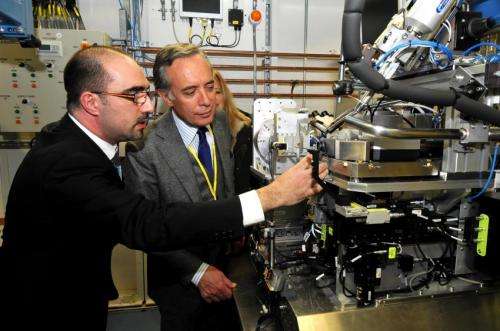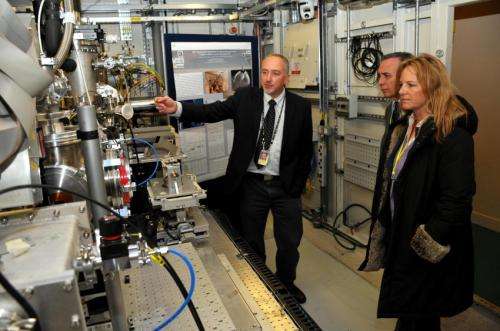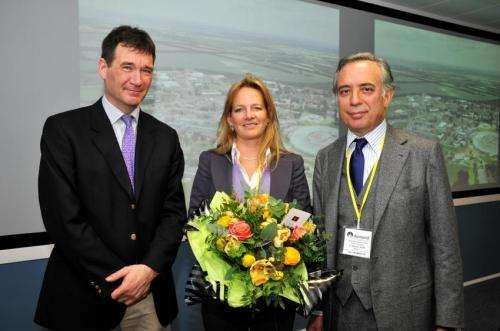Italian Ambassador visits Diamond Light Source

On 21st March, 2014, Diamond Light Source, the UK's synchrotron science facility in Oxfordshire, welcomed the Italian Ambassador, His Excellency Pasquale Terracciano.
Diamond is an advanced scientific facility used by over 3,000 academic and industrial researchers across a wide range of disciplines including structural biology, energy, engineering, nanoscience and environmental sciences. It works like a giant microscope, harnessing the power of electrons to produce light 10 billion times brighter than the sun - scientists use this light to study anything from fossils to jet engines to viruses and vaccines.
Like many world leading research centres, Diamond is a cosmopolitan place. Over 40 different countries are represented and a large proportion of the scientists are from overseas. During his visit the Ambassador met with around 20 of Diamond's Italian staff as well as a number of Italian scientists from other key facilities located on the Harwell Science & Innovation Campus.
Diamond is a hub for pioneering research, and the Ambassador's tour included an introduction to the state-of-the-art equipment and the scientific progress yielded by the UK's synchrotron. The Ambassador was given a rare view inside the tunnels that carry the electrons which produce Diamond's brilliant light, accompanied by Trevor Rayment, Director of Physical Sciences and Riccardo Bartolini, Head of Accelerator Physics. Diamond contains 23 experimental laboratories known as 'beamlines' and the group visited four of these. Each beamline is finely tuned to help scientists carry out research that could prove impossible without synchrotron light.

The first stop on the tour was B18, where the group met Giannantonio Cibin, senior beamline scientist. Giannantonio explained the work scientists were doing to preserve the Tudor warship, the Mary Rose. This ancient flagship sunk in 1545 during a battle with a French invading fleet. It was raised over 500 years later in 1982, but exposure to oxygen after many years under water caused the ship to begin decaying. Detailed studies using synchrotron light are helping scientists to develop ways of protecting the vulnerable wood and ensuring the long-term preservation of this historical relic.
Approximately 40% of Diamond's work involves the life sciences, and during his visit to B22 the Ambassador learned more about the work Diamond is doing to provide new tools in the fight against some of the world's most devastating diseases. Principal beamline scientist Gianfelice Cinque told the group about novel infrared techniques with applications for cancer research and regenerative medicine. Thanks to current work by scientists at Diamond, pioneering synchrotron techniques could provide a new way of screening patients for the early signs of cancer, thus indicating personalized treatment options and improving outcomes for patients.
From here, the Ambassador went to B23, where he heard about the progress being made in Parkinson's research at the synchrotron. Giuliano Siligardi, principal beamline scientist, talked about how this beamline was being used to investigate new methods of treating Parkinson's disease, including an antibiotic that has been shown to inhibit the disease symptoms and block the protein that causes neurodegeneration.
Finally, during a visit to I03 – the beamline where very complex biological structures, such as whole viruses, can now be studied – the Ambassador learnt from post doctoral researcher Marco Mazzorana how Diamond's MX beamlines have been used to develop an innovative new vaccine for foot and mouth disease virus (FMDV). This disease plagued the English countryside in 2001 and again in 2007 and is still endemic in much of the world; but scientists have used the MX beamlines to develop a new type of vaccine which is totally non-infectious and thus cheaper, safer and more effective.

Following this insight into the pioneering research taking place at the synchrotron the Ambassador enjoyed traditional English afternoon tea with Italian scientists and staff. His Excellency Pasquale Terracciano commented: "I'm proud to find such an important contribution by Italian scientists and technology to this very important research centre - a true beacon of global scientific research."
Andrew Harrison, Diamond's CEO, added: "As a world-class scientific facility, our success depends crucially upon attracting the very best scientists to come and work here, amongst whom are many eminent Italian scientists. We look forward to an ever brighter future in which Italian scientists continue to play a big role."
More information:
• Silvana Westbury, PR Manager, Diamond Light Source E: silvana.westbury@diamond.ac.uk
T: 01235 778238 or 07920 594660
• Mary Cruse, Press & PR Officer E: mary.cruse@diamond.ac.uk T: 01235 778548
About Diamond Light Source
• Diamond Light Source is funded by the UK Government via the Science and Technology Facilities Council (STFC) and by the Wellcome Trust.
• For more information about Diamond visit www.diamond.ac.uk
• Diamond generates extremely intense pin-point beams of synchrotron light of exceptional quality ranging from X-rays, ultra-violet and infrared. For example Diamond’s X-rays are around 100 billion times brighter than a standard hospital X-ray machine.
• Diamond Light Source is used by over 3,000 academic and industrial researchers across a wide range of disciplines including structural biology, health and medicine, solid-state physics, materials & magnetism, nanoscience, electronics, earth & environmental sciences, chemistry, cultural heritage, energy and engineering.
• Many of our everyday commodities that we take for granted, from food manufacturing to cosmetics, from revolutionary drugs to surgical tools, from computers to mobile phones, have all been developed or improved using synchrotron light.
• Diamond brings benefits to:
o Biology and medicine. For example, the fight against illnesses such as Parkinson's, Alzheimer's, osteoporosis and many cancers will benefit from the new research techniques available at Diamond.
o The physical and chemical sciences. For example, in the near future, engineers will be able to image their structure down to an atomic scale, helping them to understand the way impurities and defects behave and how they can be controlled.
o The Environmental and Earth sciences. For example, Diamond helps researchers to identify organisms that target specific types of contaminant in the environment which can potentially lead to identifying cheap and effective ways for cleaning polluted land.
Diamond Light Source